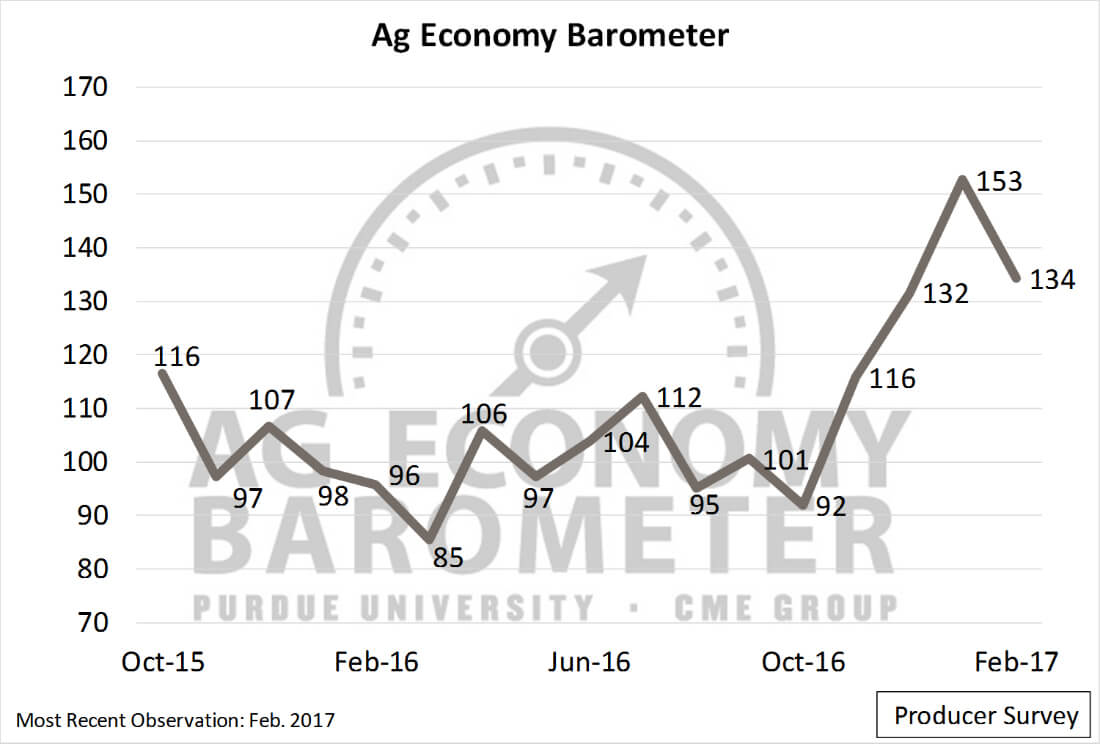March 7, 2017
Agricultural producer sentiment falls from January peak
 |
|
Agricultural producer sentiment fell by 19 points from January to February. Even with the drop, the February reading of the Purdue/CME Group Ag Economy Barometer is still the second highest since data collection began. (Purdue/CME Group Ag Economy Barometer/David Widmar) |
WEST LAFAYETTE, Ind. and CHICAGO – Agricultural producer sentiment fell in February after three straight months of gains, according to the latest reading of the Purdue/CME Group Ag Economy Barometer.
The barometer dropped to 134 in February, a 19-point decrease from January’s record high of 153. Even with the drop, the February reading is still the second-highest since data collection began in October 2015.
Both of the barometer’s component indices—the Index of Current Conditions and the Index of Future Expectations—dropped from their January levels.
“The concern producers expressed about current economic conditions is consistent with other measures of conditions in the farm economy,” said James Mintert, barometer principal investigator and director of Purdue’s Center for Commercial Agriculture. “For example, during the recent annual Agricultural Outlook Forum, USDA projected net farm income in 2017 will fall to $62 billion, a 9 percent decrease from 2016 and a 50 percent drop from the peak net farm income set in 2013.”
With uncertainty surrounding U.S. trade policy since the November election, the Purdue/CME Group survey asked producers to rate the importance of agricultural exports to the U.S. economy. Ninety-three percent reported that agricultural exports were important or very important. Nearly 80 percent also said that agricultural exports were important or very important for their individual farms.
The rapidly approaching spring planting season is another factor with the potential to influence producer sentiment. Two-thirds of February survey respondents said they expect soybeans to be more profitable than corn this year.
“Corn and soybean growers are finalizing their planting decisions as we speak,” Mintert said. “The expected profitability of corn versus soybeans in 2017 will be one of the key factors that determines the crop mix. The indications that more producers think soybeans will be more profitable means that there will be extra interest in the USDA’s annual Planting Intentions Report.”
The Planting Intentions Report releases on March 31.
Read the full February Ag Economy Barometer report at http://purdue.edu/agbarometer. This month’s report includes readings of the Index of Current Conditions and the Index of Future Expectations, as well as producer sentiment toward farmland values. The website also offers additional resources, such as past reports, charts and survey methodology, and a form to sign up for monthly barometer email updates and quarterly webinars.
The Ag Economy Barometer, Index of Current Conditions and Index of Future Expectations also are available on the Bloomberg Terminal under the following ticker symbols: AGECBARO, AGECCURC and AGECFTEX.
About the Purdue University Center for Commercial Agriculture
The Center for Commercial Agriculture was founded in 2011 to provide professional development and educational programs for farmers. Housed within Purdue University's Department of Agricultural Economics, the center’s faculty and staff develop and execute research and educational programs that address the different needs of managing in today’s business environment.
About CME Group
As the world’s leading and most diverse derivatives marketplace, CME Group (www.cmegroup.com) is where the world comes to manage risk. Through its exchanges, CME Group offers the widest range of global benchmark products across all major asset classes, including futures and options based on interest rates, equity indexes, foreign exchange, energy, agricultural products and metals. CME Group provides electronic trading globally on its CME Globex platform. The company also offers clearing and settlement services across asset classes for exchange-traded and over-the-counter derivatives through its clearinghouses CME Clearing and CME Clearing Europe. CME Group’s products and services ensure that businesses around the world can effectively manage risk and achieve growth.
CME Group, the Globe logo, CME, Chicago Mercantile Exchange, Globex and E-mini are trademarks of Chicago Mercantile Exchange Inc. CBOT, Chicago Board of Trade, KCBT and Kansas City Board of Trade are trademarks of Board of Trade of the City of Chicago, Inc. NYMEX, New York Mercantile Exchange and ClearPort are trademarks of New York Mercantile Exchange, Inc. COMEX is a trademark of Commodity Exchange, Inc. Dow Jones, Dow Jones Industrial Average, S&P 500 and S&P are service and/or trademarks of Dow Jones Trademark Holdings LLC, Standard & Poor's Financial Services LLC and S&P/Dow Jones Indices LLC, as the case may be, and have been licensed for use by Chicago Mercantile Exchange Inc. All other trademarks are the property of their respective owners.
Writer: Jennifer Stewart-Burton, 765-496-6032, jsstewar@purdue.edu
Sources: Jim Mintert, 765-494-4310, jmintert@purdue.edu
David Widmar, 765-494-0848, dwidmar@purdue.edu
Chris Grams, 312-930-3435, chris.grams@cmegroup.com
Related website:
Purdue University Center for Commercial Agriculture: http://purdue.edu/commercialag
CME Group: http://www.cmegroup.com/
Agricultural Communications: (765) 494-8415;
Darrin Pack, dpack@purdue.edu
Agriculture News Page